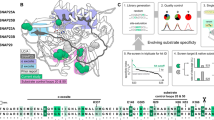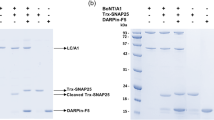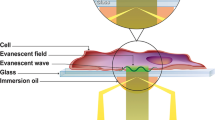Abstract
Clostridal neurotoxins (CNTs) are the causative agents of the neuroparalytic diseases botulism and tetanus1,2. CNTs impair neuronal exocytosis through specific proteolysis of essential proteins called SNAREs3. SNARE assembly into a low-energy ternary complex is believed to catalyse membrane fusion, precipitating neurotransmitter release; this process is attenuated in response to SNARE proteolysis4,5,6,7. Site-specific SNARE hydrolysis is catalysed by the CNT light chains, a unique group of zinc-dependent endopeptidases3. The means by which a CNT properly identifies and cleaves its target SNARE has been a subject of much speculation; it is thought to use one or more regions of enzyme–substrate interaction remote from the active site (exosites)8,9,10. Here we report the first structure of a CNT endopeptidase in complex with its target SNARE at a resolution of 2.1 Å: botulinum neurotoxin serotype A (BoNT/A) protease bound to human SNAP-25. The structure, together with enzyme kinetic data, reveals an array of exosites that determine substrate specificity. Substrate orientation is similar to that of the general zinc-dependent metalloprotease thermolysin11. We observe significant structural changes near the toxin's catalytic pocket upon substrate binding, probably serving to render the protease competent for catalysis. The novel structures of the substrate-recognition exosites could be used for designing inhibitors specific to BoNT/A.
This is a preview of subscription content, access via your institution
Access options
Subscribe to this journal
Receive 51 print issues and online access
$199.00 per year
only $3.90 per issue
Buy this article
- Purchase on Springer Link
- Instant access to full article PDF
Prices may be subject to local taxes which are calculated during checkout






Similar content being viewed by others
References
Humeau, Y., Doussau, F., Grant, N. J. & Poulain, B. How botulinum and tetanus neurotoxins block neurotransmitter release. Biochimie 82, 427–446 (2000)
Dolly, J. O., Black, J., Williams, R. S. & Melling, J. Acceptors for botulinum neurotoxin reside on motor nerve terminals and mediate its internalization. Nature 307, 457–460 (1984)
Schiavo, G. et al. Tetanus and botulinum-B neurotoxins block neurotransmitter release by proteolytic cleavage of synaptobrevin. Nature 359, 832–835 (1992)
Chen, Y. A., Scales, S. J., Patel, S. M., Doung, Y. C. & Scheller, R. H. SNARE complex formation is triggered by Ca2+ and drives membrane fusion. Cell 97, 165–174 (1999)
Söllner, T. et al. SNAP receptors implicated in vesicle targeting and fusion. Nature 362, 318–324 (1993)
Pellegrini, L. L., O'Connor, V., Lottspeich, F. & Betz, H. Clostridial neurotoxins compromise the stability of a low energy SNARE complex mediating NSF activation of synaptic vesicle fusion. EMBO J. 14, 4705–4713 (1995)
Xu, T., Binz, T., Niemann, H. & Neher, E. Multiple kinetic components of exocytosis distinguished by neurotoxin sensitivity. Nature Neurosci. 1, 192–200 (1998)
Rossetto, O. et al. SNARE motif and neurotoxins. Nature 372, 415–416 (1994)
Pellizzari, R. et al. Structural determinants of the specificity for synaptic vesicle-associated membrane protein/synaptobrevin of tetanus and botulinum type B and G neurotoxins. J. Biol. Chem. 271, 20353–20358 (1996)
Cornille, F. et al. Cooperative exosite-dependent cleavage of synaptobrevin by tetanus toxin light chain. J. Biol. Chem. 272, 3459–3464 (1997)
Holden, H. M., Tronrud, D. E., Monzingo, A. F., Weaver, L. H. & Matthews, B. W. Slow- and fast-binding inhibitors of thermolysin display different modes of binding: crystallographic analysis of extended phosphonamidate transition-state analogues. Biochemistry 26, 8542–8553 (1987)
Lacy, D. B., Tepp, W., Cohen, A. C., DasGupta, B. R. & Stevens, R. C. Crystal structure of botulinum neurotoxin type A and implications for toxicity. Nature Struct. Biol. 5, 898–902 (1998)
Hanson, M. A. & Stevens, R. C. Cocrystal structure of synaptobrevin-II bound to botulinum neurotoxin type B at 2.0 Å resolution. Nature Struct. Biol. 7, 687–692 (2000)
Agarwal, R., Eswaramoorthy, S., Kumaran, D., Binz, T. & Swaminathan, S. Structural analysis of botulinum neurotoxin type E catalytic domain and its mutant glu212 → gln reveals the pivotal role of the glu212 carboxylate in the catalytic pathway. Biochemistry 43, 6637–6644 (2004)
Vaidyanathan, V. V. et al. Proteolysis of SNAP-25 isoforms by botulinum neurotoxin types A, C, and E: domains and amino acid residues controlling the formation of enzyme-substrate complexes and cleavage. J. Neurochem. 72, 327–337 (1999)
Foran, P., Shone, C. C. & Dolly, J. O. Differences in the protease activities of tetanus and botulinum B toxins revealed by the cleavage of vesicle-associated membrane protein and various sized fragments. Biochemistry 33, 15365–15374 (1994)
Washbourne, P., Pellizzari, R., Baldini, G., Wilson, M. C. & Montecucco, C. Botulinum neurotoxin types A and E require the SNARE motif in SNAP-25 for proteolysis. FEBS Lett. 418, 1–5 (1997)
Li, L., Binz, T., Niemann, H. & Singh, B. R. Probing the mechanistic role of glutamate residue in the zinc-binding motif of type A botulinum neurotoxin light chain. Biochemistry 39, 2399–2405 (2000)
Binz, T., Bade, S., Rummel, A., Kollewe, A. & Alves, J. Arg(362) and Tyr(365) of the botulinum neurotoxin type A light chain are involved in transition state stabilization. Biochemistry 41, 1717–1723 (2002)
Brooijmans, N., Sharp, K. A. & Kuntz, I. D. Stability of macromolecular complexes. Proteins 48, 645–653 (2002)
Sutton, R. B., Fasshauer, D., Jahn, R. & Brunger, A. T. Crystal structure of a SNARE complex involved in synaptic exocytosis at 2.4 Å resolution. Nature 395, 347–353 (1998)
Rupp, B. & Segelke, B. Questions about the structure of the botulinum neurotoxin B light chain in complex with a target peptide. Nature Struct. Biol. 8, 663–664 (2001)
Sukonpan, C. et al. Synthesis of substrates and inhibitors of botulinum neurotoxin type A metalloprotease. J. Pept. Res. 63, 181–193 (2004)
Schmidt, J. J. & Bostian, K. A. Proteolysis of synthetic peptides by type A botulinum neurotoxin. J. Protein Chem. 14, 703–708 (1995)
Fiebig, K. M., Rice, L. M., Pollock, E. & Brunger, A. T. Folding intermediates of SNARE complex assembly. Nature Struct. Biol. 6, 117–123 (1999)
Segelke, B., Knapp, M., Kadkhodayan, S., Balhorn, R. & Rupp, B. Crystal structure of Clostridium botulinum neurotoxin protease in a product-bound state: evidence for noncanonical zinc protease activity. Proc. Natl Acad. Sci. USA 101, 6888–6893 (2004)
Matthews, B. W. Structural basis of the action of thermolysin and related zinc peptidases. Acc. Chem. Res. 21, 333–340 (1988)
Dall'Acqua, W. & Carter, P. Substrate-assisted catalysis: molecular basis and biological significance. Protein Sci. 9, 1–9 (2000)
Fasshauer, D., Bruns, D., Shen, B., Jahn, R. & Brunger, A. T. A structural change occurs upon binding of syntaxin to SNAP-25. J. Biol. Chem. 272, 4582–4590 (1997)
Debnath, A. K., Radigan, L. & Jiang, S. Structure-based identification of small molecule antiviral compounds targeted to the gp41 core structure of the human immunodeficiency virus type 1. J. Med. Chem. 42, 3203–3209 (1999)
Acknowledgements
We thank T. Binz and J. Ernst for providing initial BoNT/A and sn2 constructs and P. Adams, T. Fenn, S. Kaiser, Z. Panepucci, P. Strop and W. Weis for technical assistance and critical reading. Portions of this research were carried out at the Stanford Synchrotron Radiation Laboratory, a national user facility operated by Stanford University on behalf of the US Department of Energy (Office of Basic Energy Sciences). The SSRL Structural Molecular Biology Program is supported by the Department of Energy (Office of Biological and Environmental Research) and by the National Institutes of Health (National Center for Research Resources, Biomedical Technology Program) and the National Institute of General Medical Sciences. Portions of this research were conducted at the Advanced Light Source which is supported by the Office of Energy Research (Office of Basic Energy Sciences, Materials Sciences Division) of the US Department of Energy at Lawrence Berkeley National Laboratory. This work was supported in part by an NIH grant to A.T.B.
Author information
Authors and Affiliations
Corresponding author
Ethics declarations
Competing interests
The authors declare that they have no competing financial interests.
Supplementary information
Supplementary Information
This file contains the Supplementary Methods section of the paper with references, along with Supplementary Tables 1 and 2, and Supplementary Figures 1, 2 and 3. (PDF 428 kb)
Rights and permissions
About this article
Cite this article
Breidenbach, M., Brunger, A. Substrate recognition strategy for botulinum neurotoxin serotype A. Nature 432, 925–929 (2004). https://doi.org/10.1038/nature03123
Received:
Accepted:
Published:
Issue Date:
DOI: https://doi.org/10.1038/nature03123
This article is cited by
-
A DARPin promotes faster onset of botulinum neurotoxin A1 action
Nature Communications (2023)
-
Antidotal treatment of botulism in rats by continuous infusion with 3,4-diaminopyridine
Molecular Medicine (2022)
-
Construction and validation of safe Clostridium botulinum Group II surrogate strain producing inactive botulinum neurotoxin type E toxoid
Scientific Reports (2022)
-
Reengineering the specificity of the highly selective Clostridium botulinum protease via directed evolution
Scientific Reports (2022)
-
A neurotoxin that specifically targets Anopheles mosquitoes
Nature Communications (2019)
Comments
By submitting a comment you agree to abide by our Terms and Community Guidelines. If you find something abusive or that does not comply with our terms or guidelines please flag it as inappropriate.



